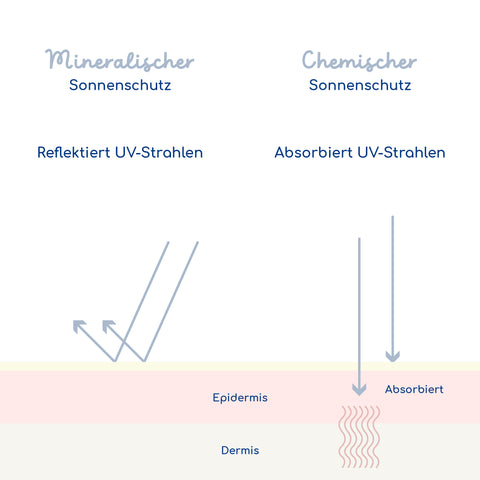
If you prefer a natural and more environmentally friendly alternative when it comes to sunscreen, you should buy mineral sunscreen. But many people wonder what the difference is between mineral and synthetic - colloquially also chemical - sunscreen. In our blog post, we have summarized the most important differences for you.
What UV filters are there?
When it comes to sunscreens, a distinction is made between two types of UV filters : organic filters, colloquially called "chemical" or "synthetic" filters, and inorganic filters, better known as "mineral" or "physical" filters. [1]
How do they differ in their mode of action?
Sunscreens with chemical UV filters penetrate the skin, absorb the sun's rays and convert them into heat energy. Mineral filters (e.g. zinc oxide or titanium dioxide), on the other hand, lie on the skin and reflect the sun's rays; they therefore form a physical barrier and prevent the UV rays from penetrating the skin cells in the first place. [2] [3]

The filter particles cause some mineral natural cosmetic sun creams to leave white residues on the skin. However, the formulas have been refined so much in recent years that there are now mineral sun creams with only a slight, so-called "whitening effect".
Note: Excessive exposure to strong sunlight increases the risk of skin cancer (UVB radiation) and accelerates skin aging (UVA radiation). Therefore, we should protect our skin, especially the skin of babies and children, which has yet to develop its own UV protection, with sufficient sunscreen . [3] We also recommend wearing protective UV clothing and avoiding the midday sun .
What does this mean for your health?
Some chemical filters are suspected of having hormonal effects, which has been proven in cell and animal experiments (e.g. ethylhexyl methoxycinnamate, octocrylene). [3] [4] According to current knowledge, the Federal Institute for Risk Assessment has so far classified one chemical sun protection factor as harmful to health; however, a re-evaluation of approved UV filters is being discussed at European level. [5]
In contrast to chemical sunscreens, mineral sunscreens work immediately after application without any exposure time and interact less with the skin cells, which is why they are often well tolerated and skin reactions rarely occur. [4]
What does this mean for the environment?
Many mineral sunscreens will label themselves as "coral friendly" , "reef friendly" or "reef safe" . However, these terms can be misleading. We therefore write on our products that they are "compliant with the Hawaii Reef Law" . This states that the use of sunscreens containing the chemical UV filters oxybenzone, octocrylene and octinoxate is prohibited by law, as the filters contribute to coral bleaching and can affect marine fauna with unclear long-term consequences. [6] [7]
It is important to us that our mineral sunscreens are good for you, your skin and also more acceptable for the environment. As certified natural cosmetics, we do not use the UV filters mentioned above and are therefore compliant with the "Hawaii Reef Law".
⇢ You can find more tips on sun protection for you and your little ones in the blog article by founder and doctor Michaela.

[1] Serpone N. et al. Inorganic and organic UV filters: Their role and efficacy in sunscreens and suncare products . Inorganica Chimica Acta, 2007, 360, 794–802
[2] Meinhard, E. Service: Sunscreens tested . For ARD | DasErste.de, 2018. Online at: https://www.daserste.de/information/politik-weltgeschehen/morgenmagazin/service/service-Sonnenschutzmittel-Test-100.html (28.05.2018)
[3] Glückskind Magazine, Sunscreen for babies and children – 7 questions and 7 answers. https://www.dm.de/glueckskind/magazin/sonnencreme-kinder-c488332.html (01.06.2019)
[4] Throl, C., Thomas, K. Sunscreen in the test: Which sun protection we recommend for the skin . In: ÖKO-TEST June 2018, 2018. Extract online at: https://www.oekotest.de/kosmetik-wellness/Sonnencreme-im-Test-Welchen-Sonnenschutz-wir-fuer-die-Haut-empfehlen_111085_1.html (24.05.2018)
[5] Federal Institute for Risk Assessment (BfR), Information, tips and recommendations on sunscreen products, 2005. Online at: https://www.bfr.bund.de/cm/343/informationen_tipps_und_empfehlungen_zu_sonnenschutzmitteln.pdf (22.08.2005)
[6] n-tv, Hawaii bans UV filters: Sunscreens harm marine animals , 2018. Online at: https://www.n-tv.de/wissen/Sonnencremes-schaden-Meerestieren-article20497528.html (26.06.2018)
[7] n-tv, Holiday paradise protects corals: Palau bans most sunscreens , 2018. Online at: https://www.n-tv.de/wissen/Palau-verbietet-Grossteil-der-Sonnencremes-article20701373.html (02.11.2018)












